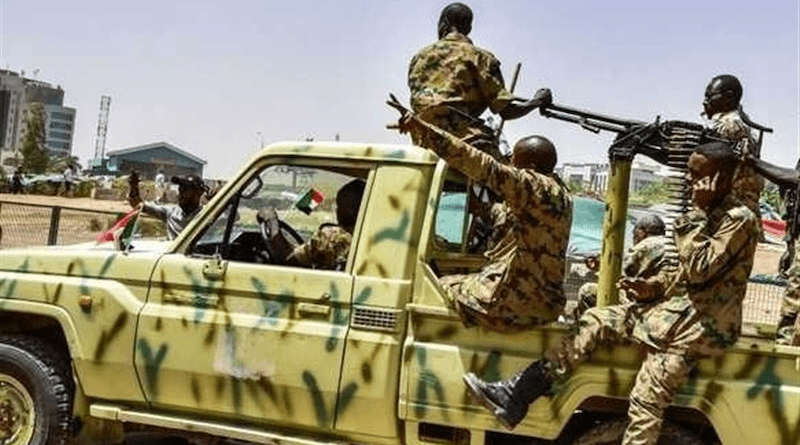The current war raging in Sudan began on April 15, 2023, with violent clashes between the Sudanese Armed Forces (SAF) and the paramilitary Rapid Support Forces (RSF). Two years later, the conflict shows no signs of abating, primarily due to the involvement of international actors supporting both factions.
A country with a turbulent history, Sudan has long been plagued by internal strife and civil wars. The roots of the current conflict can be traced back to the complex interplay of ethnic, political, and economic factors that have shaped the country’s landscape for decades. The overthrow of former President Omar al-Bashir in 2019 marked a turning point in Sudanese politics, ushering in a transitional period rife with uncertainty and power struggles.
The Rise of the RSF
Formed in 2013, the RSF originated from the Janjaweed militias, who were notorious for their role in the Darfur conflict. Initially created to combat rebel forces, the RSF quickly gained prominence and autonomy, becoming a significant power player in Sudan. The RSF leader, Mohamed Hamdan Dagalo, commonly known as Hemedti, has leveraged the RSF’s influence to position himself as a key figure in Sudanese politics. A longtime ally of al-Bashir, who had risen from an uneducated trader to one of the wealthiest men in Sudan under his rule, Dagalo participated in al-Bashir’s overthrow in 2019, ending his thirty-year rule.
The current conflict began when tensions between the SAF and RSF resulted in violent clashes. The immediate cause of the outbreak of violence is still disputed, but it’s widely believed to involve a power struggle over control of key military and political institutions between Dagalo and SAF Commander General Abdel Fattah al-Burhan. The clashes quickly escalated, spreading across the entire country and resulting in widespread death and destruction.
Foreign Actors and Their Interests
The war in Sudan has garnered attention from several foreign countries, each with its distinct strategic interests. These international actors have provided varying support to both sides in the conflict, further complicating it and hindering the prospects of a peaceful resolution.
Several countries have backed the SAF, driven by geopolitical and economic considerations. Key SAF supporters are:
Egypt. With a vested interest in Sudan’s stability, Egypt has provided military and political support to the SAF. Its support stems from concerns over potential spillover effects and the security of the Nile River resources.
Saudi Arabia. Motivated by regional security dynamics, the Kingdom of Saudi Arabia gives financial and logistical support, viewing Sudan as a crucial ally against Iranian influence in the region.Conversely, the RSF has backing from a different set of foreign nations:
United Arab Emirates (UAE). The UAE provides substantial financial assistance and military supplies to the RSF due to Dagalo’s alignment with the UAE’s regional ambitions and economic interests.
Russia. Seeking to expand its influence in Africa, Russia has supplied arms and military advice to the RSF, aiming to secure strategic footholds and counter Western influence.Impact of Foreign Support
The involvement of foreign countries has exacerbated the conflict, providing both sides with resources and legitimacy. External support has emboldened the SAF and RSF, leading to prolonged and intensified fighting. The influx of arms and financial aid has enabled sustained military campaigns, resulting in rising casualties and population displacement. Since the war began, more than 150,000 people have been killed and more than 12 million displaced.
Millions of Sudanese citizens have been caught in the crossfire of what has become a severe humanitarian crisis. International aid efforts have been hindered by the fighting, leaving many without access to essential services and aid. Refugee camps have swelled, and population displacement has led to dire living conditions and rampant disease outbreaks.
The conflict reverberates beyond Sudan’s borders, destabilizing the broader region. Neighboring countries have experienced an influx of refugees and heightened security concerns, straining their meager resources and exacerbating existing tensions. The involvement of regional powers in the conflict further complicates efforts to find a diplomatic road to peace.
Prognosis
Resolving the war in Sudan is challenging. The entrenched positions of both sides in the conflict bolstered by foreign support have created significant barriers to negotiation and compromise. The lack of a unified international strategy, combined with the conflicting interests of external actors, further hampers peace efforts.
Despite the obstacles, there are several potential pathways to peace:
A comprehensive, inclusive dialogue involving all stakeholders, including marginalized groups, could pave the way for a negotiated settlement. International mediators could facilitate such discussions, ensuring representation and addressing underlying grievances.
Coordinated international pressure, including sanctions and diplomatic efforts, could give both sides incentives to pursue peace. A coordinated, unified stance from key global players could create the leverage needed to encourage compromise.
Prioritizing humanitarian aid and support to affected populations could alleviate immediate suffering and build trust among parties to the conflict. Efforts to address the humanitarian crisis could lay the groundwork for broader peace initiatives.The war in Sudan is a complex and multifaceted conflict, deeply influenced by historical dynamics and international involvement. Ongoing support from foreign nations has intensified the fighting, hindered humanitarian efforts, and exacerbated the region’s instability. While the path to a peaceful resolution is challenging, a concerted effort by the international community, combined with inclusive dialogue and humanitarian focus, offers potential pathways to peace and stability in Sudan and the region.

